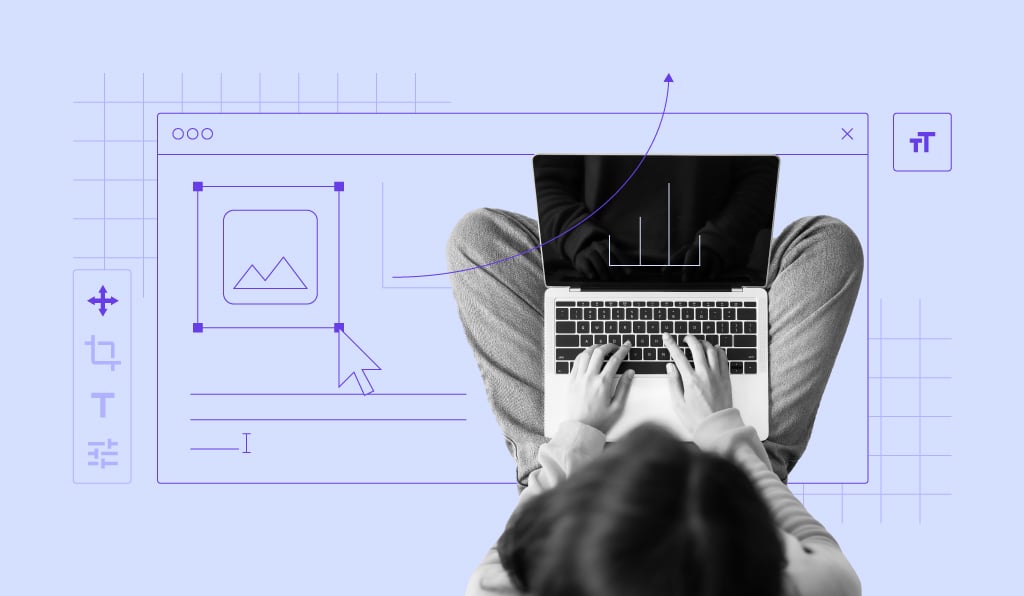Web Design London Ontario Services Designed to Your Company
Web Design London Ontario Services Designed to Your Company
Blog Article
How to Successfully Incorporate Visual Appeals and Capability in Website Design
When making a website, you need to strike an equilibrium in between visual appeals and capability. It's not practically looking good; your design should also serve a function and guide individuals successfully. By concentrating on simpleness and user-friendly navigating, you can develop an interesting experience. What elements really enhance usability while keeping visual appeal? Let's explore the key concepts that can bring about a harmonious blend of elegance and feature.
Comprehending the Value of Appearances and Performance
When you design a website, recognizing the equilibrium between aesthetic appeals and performance is crucial for creating a reliable individual experience. A visually appealing website grabs interest, but it's the capability that keeps customers involved. If your website looks wonderful yet is hard to navigate, visitors will promptly lose passion and leave.Consider your target audience and what attracts them in. You want to develop a style that shows your brand while making certain ease of usage. Structured layouts, intuitive navigation, and clear telephone calls to action can improve both aesthetic appeals and functionality.

Principles of Reliable Website Design
To produce a reliable web design, you require to follow numerous key concepts that enhance both user experience and aesthetic appeal. First, focus on simplicity; a tidy layout assists customers navigate conveniently. Make use of a consistent shade scheme and typography to preserve comprehensibility throughout your site. This promotes familiarity and trust.Next, ensure your style is receptive. Users gain access to websites on different tools, so your layout ought to adapt flawlessly. Take notice of visual hierarchy; highlight crucial components with size, color, or placement to assist customers' focus.Finally, include ample white area. It prevents mess and makes content extra absorbable. Keep in mind, effective website design balances aesthetics and functionality, so every style option ought to serve a function. By complying with these principles, you'll create a site that's not only visually attractive yet additionally user-friendly, eventually keeping visitors engaged and encouraging them to return.
Prioritizing Customer Experience
When focusing on individual experience, you'll wish to start by comprehending what your users truly require. Streamlining navigation design can make a big distinction in how easily they discover what they're trying to find. Likewise, boosting aesthetic pecking order helps lead their focus to the most essential elements on your website.
Understanding Customer Demands
Recognizing individual demands is necessary for developing an appealing internet experience that maintains visitors coming back. To attain this, you need to determine the objectives and preferences of your target audience. Begin by performing user research, like meetings or surveys, to gather understandings on what users worth most. Focus on their pain factors and obstacles when communicating with similar web sites. This information enables you to customize your layout, guaranteeing functionality lines up with customer assumptions. Additionally, think about developing individual characters that stand for various sectors of your audience, assisting you imagine their demands throughout the style procedure. When you focus on comprehending user demands, you create an internet site that not only looks terrific however also delivers a seamless, delightful experience that cultivates commitment.
Streamlining Navigation Design

Enhancing Visual Hierarchy
A solid visual hierarchy is crucial in leading users through your web site and ensuring they involve with crucial web content. To accomplish this, use dimension, color, and spacing purposefully. Make crucial elements like headings bigger and bolder than body message, drawing attention immediately. Use contrasting colors to highlight contact us to activity, encouraging clicks. In addition, employ enough white area to separate areas, making content absorbable and inviting.Consider the flow of info; arrange aspects rationally, leading users' eyes from one indicate the next. Usage aesthetic cues, like lines or arrows, to direct focus. By prioritizing aesthetic power structure, you boost individual experience and increase the chance of conversions, guaranteeing your web site is both cosmetically pleasing and functionally reliable.
Shade Concept and Its Effect on Usability
While selecting the ideal shades for your site might look like a small information, it significantly affects use and individual experience. Color affects exactly how users view info and can boost or hinder navigation. Contrasting colors can assist vital components stand out, making it easier for visitors to find what they need.Additionally, consider the psychology of colors: blue typically motivates depend on, while red develops necessity. Understanding your target market can assist your color choices, guaranteeing they reverberate well.Moreover, regular color pattern aid build brand name identity, making your web site a lot more unforgettable. website design london Ontario However, be mindful-- way too many colors can overwhelm users. Stick to a minimal scheme that enhances your material and preserves clarity.Incorporating ease of access is also essential; verify your shade mixes get along for those with visual impairments. By attentively applying color theory, you'll improve functionality and create an extra appealing user experience.
Typography: Harmonizing Style and Readability
Shade selections set the stage for your internet site, however typography plays an equally crucial function in boosting customer experience. You want your message to interact plainly while also mirroring your brand's character. Begin by picking font styles that are not only eye-catching yet additionally clear. Sans-serif typefaces commonly function well for digital displays, as they're simpler to review at various sizes.Maintain a power structure by utilizing different typeface sizes and weights; this overviews users with your web content effortlessly. Take into consideration line spacing and letter spacing; too limited can annoy viewers, while too loosened can disrupt the circulation. Limit your font style selections to 2 or three to maintain the style cohesive.Finally, always evaluate your typography across different devices and browsers. What looks good on one screen may not on one more. Balancing style with readability guarantees that your message reverberates, keeping your target market engaged and informed.
Receptive Style: Making Aesthetics Work on All Devices
To ensure your website looks wonderful on any device, you'll need to accept receptive layout concepts. This method warranties your website adapts to various screen sizes, offering an excellent individual experience. Begin by making use of liquid grids and adaptable photos that scale seamlessly. As opposed to fixed measurements, select percents and loved one devices, permitting your format to readjust dynamically.Next, implement media queries in your CSS. These let you apply various designs based upon tool attributes, like display size. By doing this, you can keep visual charm while assuring functionality.Don' t ignore touch targets; make sure switches and links are simple to tap on smaller sized displays. Prioritize essential content, so users can easily navigate your website despite their tool. By concentrating on these components, you'll produce an appealing, visually appealing experience that fulfills the demands of all individuals, whether they get on a smart device, desktop, or tablet .
Performing Use Screening for Continuous Renovation
To enhance your web design, you require to set clear functionality objectives that line up with customer demands. By carrying out user tests, you can gather useful feedback on how real individuals communicate with your website. Evaluating these outcomes will aid you make informed renovations and create an extra reliable individual experience.
Specifying Usability Goals
While aesthetics can draw customers in, defining functionality goals is important for guaranteeing their experience remains gratifying and smooth. Beginning by determining what you desire customers to accomplish on your website (website design london Ontario). Consider their demands, habits, and jobs. Are they searching for details, making an acquisition, or enrolling in a newsletter? Establish clear criteria to determine success, like job conclusion rates or time on job. Focus on instinctive navigating, accessible web content, and receptive design to enhance functionality. Consistently revisit these goals as user expectations develop. By specifying functionality objectives, you produce a framework for examining and enhancing your web site's performance. This concentrate on use not only improves individual satisfaction but additionally enhances the total performance of your layout
Carrying Out Individual Tests
Carrying out user tests is crucial for improving your website and ensuring it meets your target market's requirements. Begin by determining your target users and creating an examination strategy that describes your objectives. Make use of a mix of qualitative and measurable techniques, such as surveys, meetings, and task-based monitorings, to collect complete feedback. Invite participants to browse your website while you observe their interactions and note any problems they come across. Motivate open dialogue to record their thoughts and sensations concerning the style and capability. Keep sessions short and concentrated, ensuring you cover key locations without overwhelming customers. Lastly, make sure to document all findings, as this info will be invaluable for making enlightened design decisions that enhance both looks and functionality.
Evaluating Examination Results
How can you efficiently assess the results of your usability examinations to drive continuous renovation? Start by categorizing responses into typical motifs. Search for patterns in customer behavior that highlight pain factors or locations for enhancement. Usage quantitative information, like task completion prices and time on job, to measure functionality fairly. Don't neglect to think about qualitative insights from customer remarks; they typically disclose underlying issues that numbers can't show. Focus on one of the most impactful searchings for and create actionable products for your layout team. Bear in mind, it's about iterating-- execute adjustments, after that examination once again. This cycle of screening, evaluating, and refining assists you equilibrium aesthetics and performance, ensuring your web site fulfills individual demands properly while maintaining visual appeal.
Frequently Asked Questions
How Do I Pick the Right Shade Scheme for My Website?
To pick the appropriate shade scheme for your internet site, consider your brand's character, target audience, and emotional effect (website design london Ontario). Use color psychology, create harmony, and assurance readability. Examination combinations to see what reverberates finest with visitors
What Tools Can Help With Website Design Visual Appeals and Functionality?
You can use tools like Adobe XD, Figma, and Lay out to boost your website design's looks and capability. These systems use intuitive interfaces, cooperation attributes, and pre-made themes to improve your creative process and boost your styles.
How Can I Include Animations Without Endangering Performance?
To integrate animations without endangering performance, prioritize refined impacts that enhance customer experience. Use CSS computer animations for smoother communications, guarantee fast tons times, and test on different devices to keep efficiency while including visual allure.
What Are Typical Mistakes to Prevent in Website Design Aesthetics?
When designing, stay clear of cluttered formats, bad shade options, and irregular typefaces. Don't forget mobile responsiveness, as it can push away users. Validate your style straightens with your brand name, producing a smooth experience that engages site visitors efficiently.
Just how Typically Should I Update My Website's Design for Optimum Aesthetic Appeals?
You need to update your web site's design every 1-2 years to stay up to date with fads and maintain optimal appearances. Routinely renewing visuals aids engage guarantees and visitors your website continues to be appealing and easy to use. When you develop an internet site, understanding the balance between appearances and functionality is vital for producing a reliable user experience. To produce an efficient internet layout, you require to adhere to several essential concepts that improve both individual experience and aesthetic allure. Customers accessibility websites on different gadgets, so your style must adjust effortlessly. When focusing on customer experience, you'll want to start by understanding what your users really need. Start by conducting user research, like interviews or surveys, to gather insights on what customers worth most.
Report this page